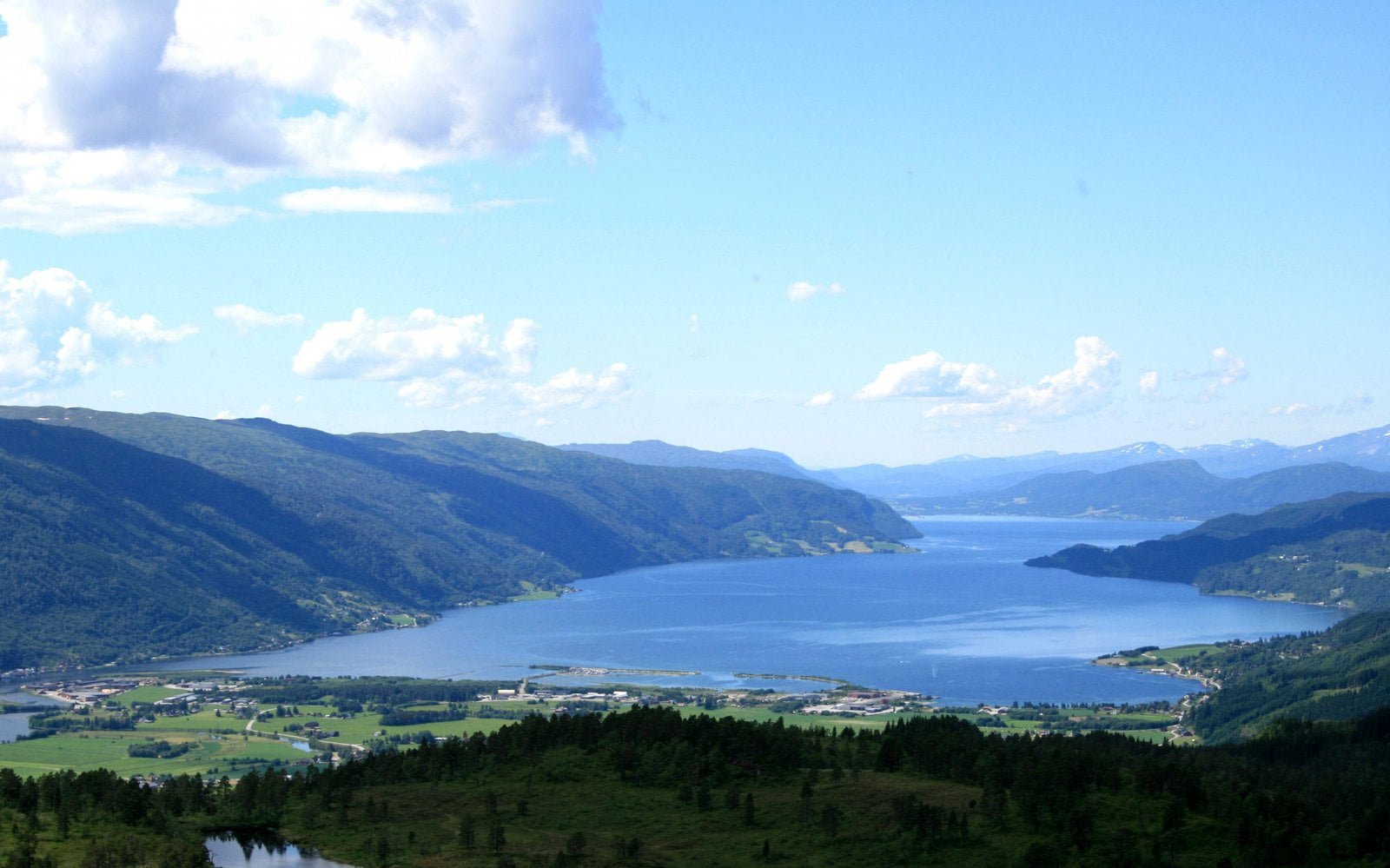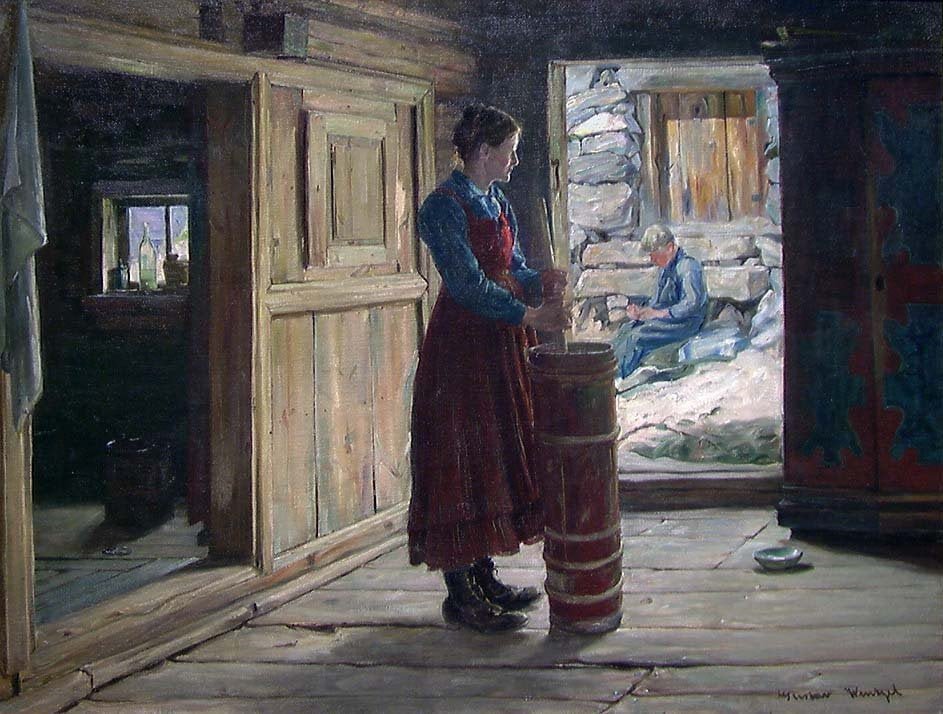«Heimar i Surnadal – band I» – author Hans Hyldbakk – copyright Surnadal kommune | Sæterhaugen – gårdsnummer 10 – bruksnummer 3 – the municipality of Surnadal, Norway – page 139.
Sæterhaugen
The houses at the cotter’s holding of Sæterhaugen were situated at the lower side of the main road (riksveien) – a bit further down the road coming from Sætertrøa. The foundations (syllmur) could still be seen there when this text was written in 1966. The houses were removed during the second world war.
To find the property on the map, try the Google map coordinates: latitude 62.99682026 longitude 8.97622471 – or try the Norwegian interactive map using the reference 1566-10/3.

Sæterhaugen farm – Surnadal – Norway. | This is a photo taken from the book «Heimar i Surnadal» – written by Hans Hyldbakk. | Copyright: Surnadal kommune.
Jo Knutson Elshaug is the first man known to be linked to this place. He was born around 1720 at Elshaug Utigard in Rindal and married Gjertrud Jonsdotter Sande, Bortistua in 1753. Their children were:
- Jo b. 1753.
- Gjertrud b. 1755.
- Raneni b. 1756, married 1779 to Lars Olson Sæter at Sæterøya.
- Knut b. 1765, married 1800 to Maret Larsdotter Heggset. They settled at Holtamelen.
Jo Knutson died in 1799 and Gjertrud Jonsdotter in 1805. She was then 80 years old.
Lars Pederson Sogge lived at Sæterhaugen at the same time as Jo Knutson. He was born in 1715 and was the brother of the cotter Peder Pederson at Honnstadøya. In 1751, Lars married Ingeborg Andersdotter Øyen b. 1718. They had three children:
- Ingeborg b. 1751, married 1784 to Anders Einarson Holten, Stoen.
- Peder b. 1755, married 1797 to Gjertrud Knutsdotter Kjerkholt. They are said to have moved to Rindal, leasing land there.
- Jo b. 1757, married 1791 to Maret Olsdotter Dønnem, and remarried 1798 to Anne Arntsdotter Sogge b. 1767, probably from Ellevsetøya.
Ingeborg Andersdotter died in 1768 and Lars Pederson in 1770.
Jo Larsson is listed as sole cotter at Sæterhaugen in 1801. With his second wife he had a daughter:
- Maret b. 1800, married 1826 to Håken Toreson Tørset b. 1800. His parents were Tor Gudmundson Fugelsøy and Gurå Håkensdotter Tørset from Rindalen. Gurå was later a cotter’s wife at Karengjeret Moen.
Jo Larsson is said to have died in 1823.
Håken Toreson Tørset got the lease at Sæterhaugen in 1826. As part of the contract he had to work for the main farm: 2 weeks during the haymaking period, 1 workday in the spring and one mæling (= a measure of land) during the grain harvest in the autumn. Håken Toreson and Maret Jonsdotter had these children:
- Jo b. 1826, died unmarried in 1854.
- Anne b. 1828, married 1860 to Ola Greusson Røv, Høgmoen.
- Guro b. 1831.
- Tore b. 1833, married 1881 to Maret Sivertsdotter Sogge, Einmoen. Tore lived and had a store at Gråva in Sylte.
- Ingeborg b. 1836.
- Maren b. 1839. She purchased kår (= support received when elderly after giving one’s estate to another) at Storholten in Rindal og died there unmarried in 1921.
- Håken b. 1841, emigrated to America.
Maret Jonsdotter died in 1844. In connection with the settling of her estate, held 29 October, we learn that her net estate was 62 speciedaler, 4 ort and 11 skilling.
In 1846, Håken Toreson remarried the widow Maret Olsdotter Bjørnås from Bjørnåsøya. She had been married to the blacksmith Tore Pederson Bjørnås at Bjørnåsøya with whom she had 5 gifted and hardworking children. They were the son Peder, who was a clockmaker and cotter at Sæterøya – the son Ola the elder who was a land consolidation judge (utskiftingsformann) and who later emigrated to America – the son Anders who was a police assistant and the first vet here in this community – the son Ola the younger who was a spinning-wheel maker and the cotter here at Sæterhaugen – and the daughter Brit, married to cotter Hallvard Pederson Bolmevollen in Rindalen.
Håken Toreson and Maret Olsdotter did not have any children together. Maret Olsdotter died in 1881. Håkon Toreson in 1888. Håken junior was the one of Håken senior’s children that stayed the longest at Sæterhaugen. Håkkå (= Håken) traded in timber and did other small-scale speculation. Among other things, he bought timber at Vindøldalen and brought with him a barrel of spirits to his log driving men. It is said that when he had sold the timber he had barely enough money left to pay off the cost of the barrel. But the old people hereabouts say that after Håkkå came to America he became a wealthy man.
Ola Toreson Bjørnås, Håken senior’s wife’s son, got the lease on the property in 1880. He paid 800 kroner in lease cost and had to work 2 weeks during the haymaking period, 2 workdays during the autumn and 1 day of roadwork during håbolla (= the period between the farm work in the spring and the haymaking period). He had grassland up at Langmarka and could normally feed 4 cows at Sæterhaugen. The census of 1875 tells us that Ola Toreson already had 1 cow and 6 sheep on the property – and at the same time, Håken Toreson had 2 cows and 6 sheep. The sowing seed was 1 kvartil (= a quarter of a barrel) barley, 1.5 barrel of oat and 3 barrels of potatoes.
Ola Toreson is listed as a spinning wheel maker and he is said to be the best craftsman within that field in these whereabouts. The spinning wheels from Sæterhaugen were famous both near and far and were said to be the best and the lightest one could get. In Valsøyfjorden and Aure lived elderly women who in more recent times have said that they in their youth went on foot across the landscape quite some distances with the spinning wheels on their back. The price was 8 kroner.
Ola Toreson was born 1839, married 1862 to Brit Olsdotter Røv from Røvsøya, b. 1836. They had eight children:
- Ola b. 1863, clockmaker, married to Karen Olsdotter Krangnes. They lived in Surnadalsøra.
- Tore b. 1864, died when he was a child.
- Peder b. 1866, a shopowner in Sande, married 1893 to Maret Jonsdotter Mogstad. They had the daughter Birgitte Sæter b. 1898 married to Sergeant Anders Moen.
- Jo b. 1869, died when he was a child.
- Ola b. 1873, died 1874.
- Maret b. 1877, emigrated to America 1902, married to Lars Larsson Moen, Myran.
- Gurå b. 1880, married to Bersvein Rian in Trondheim. They had the sons Johan B. Rian, chaplain in Lademoen, married to Kjellrun Isaksdotter Telstad – and Bjørn Rian, manager (disponent) at Globusforlaget, Trondheim.
- Brit b. 1883, married 1912 to merchant manager (handelsstyrar) Ola Olson Kattem.
Ola Toreson travelled to America and stayed there for several years. In the meantime, his brother Peder looked after Sæterhaugen for him. Ola was the last person who had a lease on the property. He died at his son’s house in Sande in 1923, and his wife Brit Olsdotter died the year before.
Anton Helmerson Harang got Sæterhaugen – including more land – as a freehold in 1915. Anton was born 16 May 1895 and in 1914 he married Gjertrud Olsdotter Sæter, b. 12 July 1893. Their children were:
- Lars b. 15 May 1915, married to Adeline Marie Arnberger b. 9 November 1919 in the USA. Children: Alwood Anthony b. 19 September 1953, Kathrine Louise b. 9 December 1955.
- Gerda b. 26 August 1916, married to Walter Hohn Eeastman b. 7 April 1911 in the USA. Children: Walter John b. 17 December 1940, William Arthur b. 25 May 1943.
- Anna b. 6 June 1918, married to Anton Haugen b. 21 July 1910 in Sirdal. Children: Tillei
- Ann b. 24 August 1956.
- Ola b. 25 July 1920, married to Marion Hendersen b. 25 August 1923 in the USA. Children: Gordon Samual b. 10 November 1946, Arne Lon b. 24 August 1956.
Eli b. 27 January 1922, married to Irank Olen Treese b. 27 June 1918 in the USA. Children: Gertrud Ann b. 6 September 1942, Barbara Jean b. 16 November 1944, Irank - Olen b. 1 September 1946.
Anton Harang emigrated to America with his family and Erik Olson Håndstad purchased Sæterhaugen from him. Erik was born in 1857 at Honnstadvollen and died unmarried at Øvre Sæter in 1934. In his will he gave Sæterhaugen to Toralf Sveen, married to Brit Rindalsholt. They moved to Rindalen and settled there and sold the property in 1939 to Nils Dalseg, who again sold it to Ola Todal at Skjermo. Ola built a new haybarn at Sæterhaugen and sold the old buildings to Ola Jonson Dønnem who rebuilt them at Rindalsskogen. These houses at Sæterhaugen originally came from the farm Solheim, and from what the elders tell us, the main house was once the «grand house» (bestestue) at Solheim when the farm served as a military residence. They were large and grand log houses and was probably rebuilt at Sæterhaugen around 1850.
The buildings that were located at Sæterhaugen prior to 1850 were purchased by the goldsmith Flor in Kristiansund and were rebuilt there.
Margit Olsdotter Sæter reclaimed the farm using her odel (= if the property is sold to a stranger, family members have the right within a specified period of time to redeem it at the price paid) and sold it to her brother Guttorm Olson Sæter at Sagatrøa of Røv, he held the deed of the property as per 1966.
Copyright and disclaimer: no copyright infringement is intended – the copyright of the original material belongs to the author and publisher. This is a non-professional translation by LA Dahlmann based on the text found on pages 139 – 143 in the book «Heimar i Surnadal – band I» written in Norwegian by the eminent Surnadal poet and historian Hans Hyldbakk – published in 1966 by Surnadal kommune. The translation may contain unintended errors, inaccuracies or omissions.











